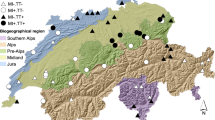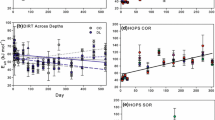Abstract
Geological factors influence biological cycling of organic carbon in soils but are not well represented in our understanding of Arctic carbon dynamics. Landscape age, for instance, directly affects quantity and quality of soil carbon, which are two strong controls of the temperature sensitivity of soil organic matter. We investigated soil carbon storage, respiration potential, and organic matter quality for microbial decomposition across a climate and landscape age gradient in southwest Greenland that deglaciated during the Holocene. We measured soil respiration during a 370-day laboratory incubations of active layer soils collected from four study areas across this gradient (ages 1.8 × 102, 6.8 × 103, and 1.0 × 104, coinciding with a climate gradient from drier inland to wetter coastal terrain) and used a soil respiration model comparison approach to assess the substrate quality of stored organic matter for microbial decomposers. Soils store more than three times greater organic carbon at the 10,000-year-old, maritime climate study areas than the 180-year-old, continental climate study areas. Respiration rates were highest in the surface soils of the coastal areas. Model comparisons reveal important heterogeneity in the quality of organic matter for microbial decomposition between areas: coastal soils were best modeled by both one- and two-pooled models, and inland soils were best represented by one-pooled respiration models. Together, the measures of carbon quality (C:N, CO2 production, and model parameters estimating initial CO2 production rates from different organic matter pools) show that shallow soils at the southern coastal area, Kobbefjord, had the highest respiration rates from the recalcitrant carbon pool. This study reveals differences in carbon storage and turnover associated with landscape age and climate factors in western Greenland. When applied to thermodynamic theory, which predicts that temperature sensitivity increases with carbon recalcitrance, our findings suggest that carbon stored in coastal soils may be more sensitive to climate warming than inland soils.








Similar content being viewed by others
References
Anderson NJ, D’Andrea W, Fritz SC (2009) Holocene carbon burial by lakes in SW Greenland. Glob Change Biol 15:2590–2598. doi:10.1111/j.1365-2486.2009.01942.x
Bennike O (2000) Palaeoecological studies of Holocene lake sediments from west Greenland. Palaeogeogr Palaeoclimatol Palaeoecol 155:285–304. doi:10.101/S0031-0184(99)00121-2
Bockheim JG, Hinkel KM, Eisner WR, Dai XY (2004) Carbon pools and accumulation rates in an age-series of soils in drained thaw-lake basins, Arctic Alaska. Soil Sci Soc Am J 68:697–704. doi:10.2136/sssaj2004.6970
Bosatta E, Agren GI (1999) Soil organic matter quality interpreted thermodynamically. Soil Biol Biochem 31:1889–1891. doi:10.1016/S0038-0717(99)00105-4
Chapin FS, Shaver GR (1989) Differences in growth and nutrient use among arctic plant growth forms. Funct Ecol 3:73–80. doi:10.2307/2389677
Conant RT, Ryan MG, Agren GI, Birge HE, Davidson EA, Eliasson PE, Evans SE, Frey SD, Giardina CP, Hopkins FM, Hyvonen R, Kirschbaum MUF, Lavalle JM, Leifeld J, Parton WJ, Steinweg JM, Wallenstein MD, Martin Wetterstedt JA, Bradford MA (2011) Temperature and soil organic matter decomposition rates—synthesis of current knowledge and a way forward. Glob Change Biol 17:3392–3404. doi:10.1111/j.1365-2486.2011.02496.x
Crocker RL, Major J (1955) Soil development in relation to vegetation and surface age at Glacier Bay, Alaska. J Ecol 43:427–448
Curiel Yuste J, Baldocchi DD, Gershenson A, Goldstein A, Misson L, Wong S (2007) Microbial soil respiration and its dependency on carbon inputs, soil temperature and moisture. Glob Change Biol 13:1–18. doi:10.1111/j.1365-2486.2007.01415.x
Danish Meteorological Institute. Climatic Normals for Greenland. http://www.dmi.dk/groenland/arkiver/klimanormaler/. Accessed 23 Sept 2014
Ehrenfeld JG, Ravit B, Elgersma K (2005) Feedback in the plant-soil system. Annu Rev Environ Resour 30:75–115. doi:10.1146/annurev.energy.30.050504.144212
Elzein T, Blarquez O, Gauthier O, Carcaillet C (2011) Allometric equations for biomass assessment of subalpine dwarf shrubs. Alp Bot 121:129–134
Giblin AE, Nadelhoffer KJ, Shaver GR, Laundre JA, McKerrow AJ (1991) Biogeochemical diversity along a riverside toposequence in arctic Alaska. Ecol Monogr 61:415–435. doi:10.2307/2937049
Hobbie SE, Schimel JP, Trumbore SE, Randerson JR (2000) Controls over carbon storage and turnover in high-latitude soils. Glob Change Biol 6:196–210. doi:10.1046/j.1365-2486.2000.06021.x
Hugelius G, Strauss J, Zubrzycki S, Harden JW, Schuur EAG, Ping CL, Schirrmeister L, Grosse G, Michaelson GJ, Koven CD, O’Donnell JA, Elberling B, Mishra U, Camill P, Yu Z, Palmtag J, Kuhry P (2014) Estimated stocks of circumpolar permafrost carbon with quantified uncertainty ranges and identified data gaps. Biogeosciences 11:6573–6593. doi:10.5194/bg-11-6573-2014
Jenny H (1941) Factors of soil formation: a system of quantitative pedology. Dover Publications, New York
Jensen L, Schmidt L, Hollesen J, Elberling B (2006) Accumulation of soil organic carbon linked to Holocene sea level changes in West Greenland. Arct Antarct Alp Res 38(3):378–383. doi:10.1657/1523-0430(2006)38[378:AOSOCL]2.0.CO;2
Jones A, Stolbovoy V, Tarnocai C, Broll G, Spaargaren O, Montanarella O (2009) Soil atlas of the Northern Circumpolar Region. Office for Official Publications of the European Communities, Luxembourg
Karhu K, Auffret MD, Dungait AJ, Hopkins DW, Prosser JI, Singh BK, Subke JA, Wookey PA, Agren GI, Sebastia MT, Gouriveau F, Bergkvist G, Meir P, Nottingham AT, Salinas N, Hartley IP (2014) Temperature sensitivity of soil respiration rates enhanced by microbial community response. Nature 513:81–84. doi:10.1038/nature13604
Knoblauch C, Beer C, Sosnin A, Wagner D, Pfeiffer EM (2013) Predicting long-term carbon mineralization and trace gas production from thawing permafrost of Northeast Siberia. Glob Change Biol 19:1160–1172. doi:10.1111/gcb.12116
Levy LB, Kelly MA, Howley JA, Virginia RA (2012) Age of the Orkendalen moraines, Kangerlussuaq, Greenland: constraints on the extent of the southwestern margin of the Greenland Ice Sheet during the Holocene. Quat Sci Rev 52:1–5. doi:10.1016/j.quascirev.2012.07.021
McGuire AD, Anderson LG, Christensen TR, Dallimore S, Guo L, Hayes DJ, Heimann M, Lorenson TD, Macdonald RW, Roulet N (2009) Sensitivity of the carbon cycle in the Arctic to climate change. Ecol Monogr 79(4):523–555. doi:10.1890/08-2025.1
Mernild SH, Hanna E, McConnell JR, Sigl M, Beckerman AP, Yde JC, Cappelen J, Malmros JK, Steffen K (2015) Greenland precipitation trends in a long-term instrumental climate context (1890–2012): evaluation of coastal and ice core records. Int J Climatol 35:303–320. doi:10.1002/joc.3986
Nadelhoffer KJ, Giblin AE, Shaver GR, Laundre JA (1991) Effects of temperature and substrate quality on element mineralization in six Arctic soils. Ecology 72:242–253. doi:10.2307/1938918
Nielsen UN, Wall DH (2013) The future of soil invertebrate communities in polar regions: different climate change responses in the Arctic and Antarctic? Ecol Lett 16:409–419. doi:10.1111/ele.12058
Ozols U, Broll G (2003) Soil ecological processes in vegetation patches of well drained permafrost affected sites (Kangerlussuaq—West Greenland). Polarforschung 73:5–14. http://hdl.handle.net/10013/epic.29907
Riggs CE, Hobbie SE, Bach EM, Hofmockel KS, Kazanski CE (2015) Nitrogen addition changes grassland soil organic matter decomposition. Biogeochemistry 125:203–219. doi:10.1007/s10533-015-0123-2
Roberts DH, Long AJ, Schnabel C, Davies BJ, Xu S, Simpson MJR, Huybrechts P (2009) Ice sheet extent and early deglaciation history of the southwestern sector of the Greenland Ice Sheet. Quat Sci Rev 28:2760–2773. doi:10.1016/j.quascirev.2009.07.002
Schmidt MWI, Torn MS, Abiven S, Dittmar T, Guggenberger G, Janssens IA, Kleber Markus, Kogel-knabner I, Lehmann J, Manning DAC, Nannipieri P, Rasse DP, Weiner S, Trumbore SE (2011) Persistence of soil organic matter as an ecosystem property. Nature 478:49–56. doi:10.1038/nature10386
Shaver GR, Bret-Harte SM, Jones MH, Johnstoone J, Gough L, Laundre J, Chapin FS (2001) Species composition interacts with fertilizer to control long-term change in tundra productivity. Ecology 82:3163–3181. doi:10.1890/0012-9658(2001)082[3163:SCIWFT]2.0.CO;2
Shaver GR, Giblin AE, Nadelhoffer KJ, Thieler KK, Downs MR, Laundre JA, Rastetter EB (2006) Carbon turnover in Alaska tundra soils: effects of organic matter quality, temperature, moisture and fertilizer. J Ecol 94:740–753. doi:10.1111/j.1365-2745.2006.01139.x
Sjogersten S, Wookey PA (2005) The role of soil organic matter quality and physical environment for nitrogen mineralization at the forest-tundra ecotone in Fennoscandia. Arct Antarct Alp Res 37:118–126. doi:10.1657/1523-0430(2005)037[0118:TROSOM]2.0.CO;2
Stieglitz M, Shaman J, McNamara J, Engel V, Shanley J, Kling GW (2003) An approach to understanding hydrologic conductivity on the hillslope and the implications for nutrient transport. Glob Biogeochem Cycles. doi:10.1029/2003GB002041
Sullivan PF, Arens SJT, Chimner RA, Welker JM (2008) Temperature and microtopography interact to control carbon cycling in a high arctic fen. Ecosystems 11:61–76. doi:10.1007/s10021-007-9107-y
Van Wijk MG, Clemmensen KE, Shaver GR, Williams M, Callaghan TV, Chapin FS, Cornelissen JHC, Gough L, Hobbie SE, Jonasson S, Lee JA, Michelsen A, Press MC, Richardson SJ, Rueth H (2003) Long-term ecosystem level experiments at Toolik Lake, Alaska, and at Abisko, Northern Sweden: generalizations and differences in ecosystem and plant type responses to global change. Glob Change Biol 10:105–123. doi:10.1111/j.1365-2486.2003.00719.x
Weintraub MN, Schimel JP (2005) Nitrogen cycling and the spread of shrubs control changes in the carbon balance of arctic tundra ecosystems. Bioscience 55:408–415. doi:10.1641/0006-3568(2005)055[0408:NCATSO]2.0.CO;2
Whittinghill KA, Hobbie SE (2011) Effects of Landscape Age on Soil Organic Matter Processing in Northern Alaska. Soil Sci Soc Am J 75:907–917. doi:10.2136/sssaj2010.0318
Whittinghill KA, Hobbie SE (2012) Effects of pH and calcium on soil organic matter dynamics in Alaska tundra. Biogeochemistry 111:569–581. doi:10.1007/s10533-011-9688-6
Zona D, Lipson DA, Zulueta RC, Oberbauer SF, Oechel WC (2011) Microtopographic controls on ecosystem functioning in the Arctic coastal plain. J Geophys Res 116:1–12. doi:10.1029/2009JG00124
Acknowledgments
We thank Courtney Hammond-Wagner and Phoebe Racine for assistance in the field and laboratory. Angela Spickard and Paul Zietz at Dartmouth provided laboratory support. We are grateful to Josephine Nymand, Louise Holm Christensen, and Stine Hojlund Pedersen for guidance and hospitality at Nuuk Basic Field Station in Kobbefjord; CH2M Hill Polar Services for logistical support in Kangerlussuaq; Lauren Culler for providing comments on the manuscript. This research was supported by a grant from The Explorers Club Exploration Fund to Julia Bradley-Cook and a National Science Foundation IGERT Grant (Award No.: 0801490) to Ross Virginia. Additional support was provided by the Institute of Arctic Studies, Dickey Center for International Understanding, Dartmouth.
Author information
Authors and Affiliations
Corresponding author
Rights and permissions
About this article
Cite this article
Bradley-Cook, J.I., Virginia, R.A. Soil carbon storage, respiration potential, and organic matter quality across an age and climate gradient in southwestern Greenland. Polar Biol 39, 1283–1295 (2016). https://doi.org/10.1007/s00300-015-1853-2
Received:
Revised:
Accepted:
Published:
Issue Date:
DOI: https://doi.org/10.1007/s00300-015-1853-2




